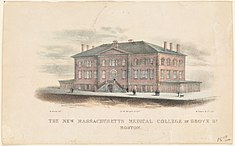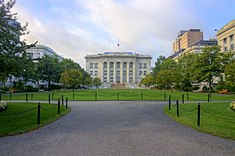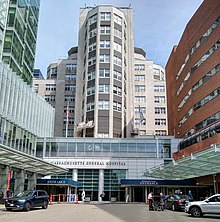
The Warren Alpert Medical School is the medical school of Brown University, located in Providence, Rhode Island. Originally established in 1811, it was the third medical school to be founded in New England after only Harvard and Dartmouth. However, the original program was suspended in 1827, and the four-year medical program was re-established almost 150 years later in 1972, granting the first MD degrees in 1975.

Massachusetts General Hospital is the original and largest teaching hospital of Harvard Medical School, Harvard University located in the West End neighborhood of Boston, Massachusetts. Massachusetts General Hospital houses the world's largest hospital-based research program, the Mass General Research Institute, with an annual research budget of more than $1.2 billion in 2021. It is the third-oldest general hospital in the United States with a patient capacity of 999 beds. Along with Brigham and Women's Hospital, Mass General is a founding member of Mass General Brigham, formerly known as Partners HealthCare, the largest healthcare provider in Massachusetts.

The Tufts University School of Medicine is the medical school of Tufts University, a private research university in Massachusetts. It was established in 1893 and is located on the university's health sciences campus in downtown Boston. It has clinical affiliations with numerous doctors and researchers in the United States and around the world, as well as with its affiliated hospitals in both Massachusetts, and Maine.
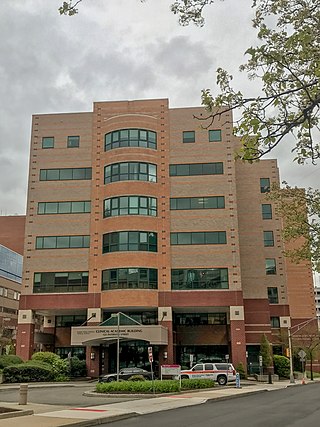
Rutgers Robert Wood Johnson Medical School is a medical school of Rutgers University. It is one of the two graduate medical schools of Rutgers Biomedical and Health Sciences, together with New Jersey Medical School, and is closely aligned with Robert Wood Johnson University Hospital, the medical school's principal affiliate.
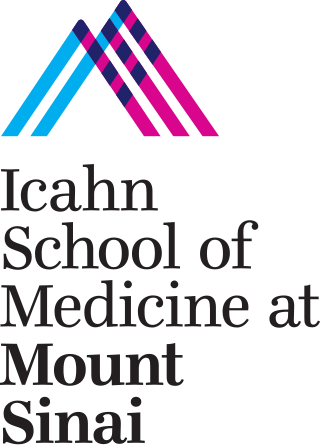
The Icahn School of Medicine at Mount Sinai, formerly the Mount Sinai School of Medicine, is a private medical school in New York City, New York, United States. The school is the academic teaching arm of the Mount Sinai Health System, which manages eight hospital campuses in the New York metropolitan area, including Mount Sinai Hospital and the New York Eye and Ear Infirmary.
The Harvard–MIT Program in Health Sciences and Technology, or HST, is one of the oldest and largest biomedical engineering and physician-scientist training programs in the United States. It was founded in 1970 and is the longest-standing collaboration between Harvard University and the Massachusetts Institute of Technology (MIT). Within the program, graduate and medical students are registered with both MIT and Harvard and may work with faculty and affiliated faculty members from both communities. HST is a part of MIT's Institute for Medical Engineering and Science and forms the London Society at Harvard Medical School.

The University of California, San Diego School of Medicine is the graduate medical school of the University of California, San Diego, a public land-grant research university in La Jolla, California. It was the third medical school in the University of California system, after those established at UCSF and UCLA, and is the only medical school in the San Diego metropolitan area. It is closely affiliated with the medical centers that are part of UC San Diego Health.

Wake Forest University School of Medicine is the medical school of Wake Forest University, with two campuses located in Winston-Salem, North Carolina and Charlotte, North Carolina, United States. It is affiliated with Atrium Health Wake Forest Baptist, the academic medical center whose clinical arm is Atrium Health Wake Forest Baptist. In 2021, U.S. News & World Report ranked Wake Forest School of Medicine 48th best for research in the nation and 80th best for primary care. The School of Medicine also ranks in the top third of U.S. medical schools in funding from the National Institutes of Health (NIH).
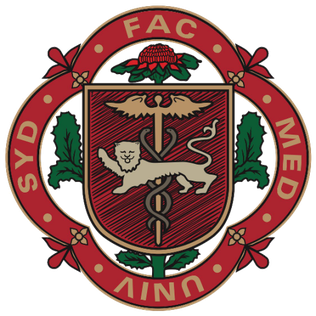
The University of Sydney School of Medicine, also known as Sydney Medical School (SMS) is the graduate medical school of the University of Sydney. Established in 1856, it is the first medical school in Australia. In 2018, Sydney Medical School joined the newly formed Faculty of Medicine and Health at the University of Sydney. SMS is ranked 19th in the world and second in Australia in the 2021 QS Subject Rankings for medicine.

The State University of New York Upstate Medical University is a public medical school in Syracuse, New York. Founded in 1834, Upstate is the 15th oldest medical school in the United States and is the only medical school in Central New York. The university is part of the State University of New York (SUNY) system.

Boston University Chobanian & Avedisian School of Medicine (CAMED), formerly known as Boston University School of Medicine, is the medical school of Boston University, a private research university in Boston. It was founded in 1848. The medical school was the first institution in the world to formally educate female physicians. Originally known as the New England Female Medical College, it was subsequently renamed Boston University School of Medicine in 1873, then Chobanian & Avedisian School of Medicine in 2022. In 1864, it became the first medical school in the United States to award an M.D. degree to an African-American woman.

Carola Blitzman Eisenberg was an Argentine-American psychiatrist who became the first woman to hold the position of Dean of Students at the Massachusetts Institute of Technology. From 1978 to 1990, she was the dean of student affairs at Harvard Medical School (HMS). She was a long-time lecturer in the Department of Global Health and Social Medicine at HMS. She was also both a founding member of Physicians for Human Rights and an honorary psychiatrist with the Massachusetts General Hospital in Boston. After retiring, she was involved in human rights work through Physicians for Human Rights, the Institute for Healthcare Improvement, and elsewhere. She turned 100 in September 2017 and died in Lincoln, Massachusetts, in March 2021 at the age of 103.
The University of Arizona College of Medicine – Tucson, located in Tucson, Arizona, is one of three MD granting medical schools in the state of Arizona, affiliated with the University of Arizona. The University of Arizona College of Medicine – Phoenix was initially established as a branch campus in 2007, but became an independent medical school in 2012. The College of Medicine – Tucson campus is located at the University of Arizona Health Sciences (UAHS) center on the campus of the University of Arizona and is governed by the Arizona Board of Regents. Traditionally, the college accepted Arizona residents exclusively. However, beginning the 2009–2010 incoming class, the school changed its policy to allow for admission of "highly-qualified," non-residents.
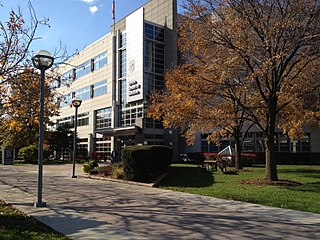
Stritch School of Medicine is the medical school affiliated with Loyola University Chicago. It is located at the heart of the Loyola University Medical Center in Maywood, Illinois. The medical campus includes Foster G. McGaw Hospital, Cardinal Bernardin Cancer Center, Center for Translational Research and Education, the Loyola Outpatient Center, the Loyola University Center for Health and Fitness along with other administrative buildings and departments that branch off from the hospital. While the Loyola University hospital, outpatient clinic and satellite sites serve as the main places of teaching, the Edward Hines Veterans Administration (VA) hospital is within walking distance and also serves as a teaching hospital for the Stritch School of Medicine.

Harvard University is a private Ivy League research university in Cambridge, Massachusetts. Founded in 1636 as Harvard College and named for its first benefactor, Puritan clergyman John Harvard, it is the oldest institution of higher learning in the United States. Its influence, wealth, and rankings have made it one of the most prestigious universities in the world.
The Robert Larner College of Medicine is the medical school of the University of Vermont, a public research university in Burlington, Vermont. Established in 1822, it is the nation's seventh oldest medical school. The primary teaching hospital for the Larner College of Medicine is the UVM Medical Center in Burlington.

Jeffrey Karp is a Canadian biomedical engineer working as a Professor of Medicine at Harvard Medical School, Brigham and Women's Hospital, and the principal faculty at the Harvard Stem Cell Institute and Affiliate Faculty at the Massachusetts Institute of Technology through the Harvard–MIT Division of Health Sciences and Technology. He is also an affiliate faculty at the Broad Institute.

Irving M. London was a hematologist and geneticist. He was an associate professor of medicine at Columbia University College of Physicians and Surgeons when he was selected to be the founding chair of the department of medicine at the Albert Einstein College of Medicine in 1955. He was recruited to become the founding director of the Harvard-MIT Program in Health Sciences and Technology in 1970. Dr. London was the first professor to hold dual roles at both Harvard and MIT.
Joan Y. Reede is an American physician. She is Harvard Medical School's inaugural dean for diversity and community partnership in the Office of Diversity, Inclusion, and Community Partnership. She is also a member of the National Academy of Medicine. She is known for creating programs that mentor and support minority physicians and female physicians. Alumni of her programs have created a 501(c)(3) organization called The Reede Scholars in her honor.
Daniel David Federman, was an American endocrinologist and the Carl W. Walter Distinguished Professor of Medicine and the dean for medical education at Harvard Medical School. He helped change medical education at through its New Pathway curriculum around the early 1990s, and his work helped create the field of genetic endocrinology. Federman also worked for over thirty years at Boston's Brigham and Women's Hospital, a Harvard teaching hospital in the Longwood Medical and Academic Area.



